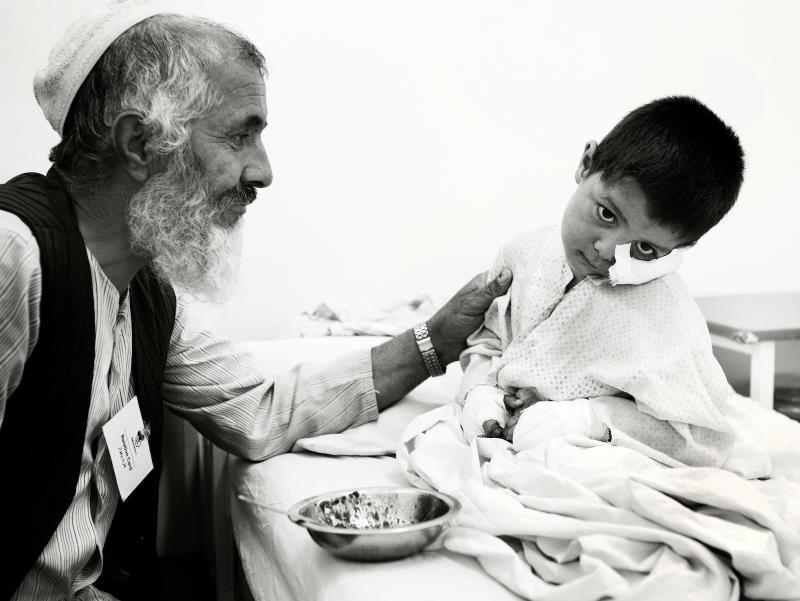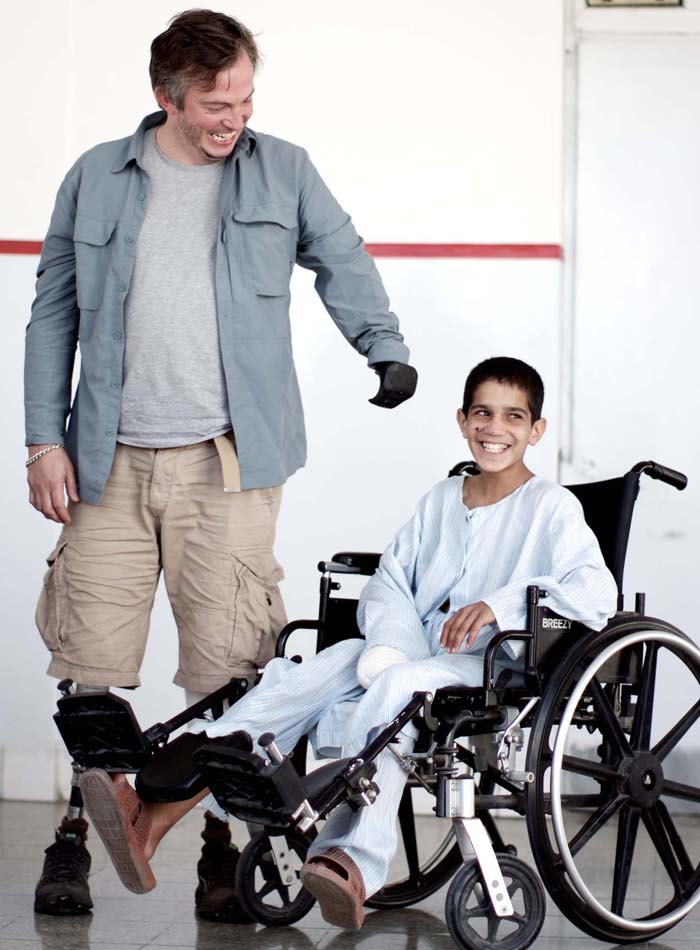Walking Wounded: Return to the Frontline, Channel 4 | reviews, news & interviews
Walking Wounded: Return to the Frontline, Channel 4
Walking Wounded: Return to the Frontline, Channel 4
Injured conflict photographer Giles Duley makes a cathartic visit to Afghanistan

The public rarely sees the human cost of journalists covering war. More rarely still does it see the real civilian cost. That makes Walking Wounded a frank and refreshing insight into the world at either end of the lens.
His project - to photograph work in a Kabul hospital that specializes in restorative treatment for locals who have suffered similar injuries. Something of a baptism of fire? “I wake up some mornings and I think ‘somewhere right now, kids are going through what I was going through,'” Duley counters. “And I think ‘how could I not go and tell those stories now’?”
Duley’s as good a guide as we could get, a man who describes himself as “photographer, writer, story-teller, red-wine drinker, triple-amputee.” In that order. He’s a photographer first, whose warm, modest personality helps him strike a bond with his subjects as much as their shared trauma. Duley and his experiences become therapy for the victims he meets in Kabul, and they become part of his therapy, too. The viewer sees Kabul’s Italian-run Emergency medical charity hospital and its patients largely through Duley’s lens - rested on his prosthetic arm or held in his one hand - and in their own words. The footage, sprinkled with his colour and black-and-white stills, is striking but stops short of being graphic or gratuitous.
 Duley freely admits to the fear and paranoia that accompany his return to Afghanistan. A third of the country’s 55,000 amputees are children whose lives have been blown apart while doing something as simple as walking to school or gathering firewood. We meet one, 10-year-old Sediqullah (pictured right with Duley), who lost three fingers playing with a piece of metal that turned out to be a detonator. He’s one of the lucky ones. Sediqullah has come with his father from the Panjshir Valley, a few hours north of Kabul, one of the most heavily mined places in the world.
Duley freely admits to the fear and paranoia that accompany his return to Afghanistan. A third of the country’s 55,000 amputees are children whose lives have been blown apart while doing something as simple as walking to school or gathering firewood. We meet one, 10-year-old Sediqullah (pictured right with Duley), who lost three fingers playing with a piece of metal that turned out to be a detonator. He’s one of the lucky ones. Sediqullah has come with his father from the Panjshir Valley, a few hours north of Kabul, one of the most heavily mined places in the world.
Many Afghans die before they reach help, which is sometimes days away. Even the lucky ones who make it to the Emergency Hospital – a distinctive white-walled compound of serenity in the chaotic dusty streets of the Afghan capital – face an uncertain future.
In contrast, Duley himself was medevaced by chopper to a military hospital within minutes of being blown up, the begnning of a long process of recovery. We see a tearful reunion in a Chicago bar with two of his rescuers, CJ and Phil, when Duley makes a speaking trip to the US just before returning to Afghanistan. “It wasn’t your day, man. It was not your day,” says one as they hug.
This may be the Giles Duley story, but it is not his alone. For those, like this reviewer, who have spent time in Afghanistan and fallen in love with this achingly beautiful country and its proud and tough people, Walking Wounded is chilling and heart-rending. For those who have not, it should be compulsory viewing – especially for jingoistic politicians.
rating
Explore topics
Share this article
Add comment
The future of Arts Journalism
You can stop theartsdesk.com closing!
We urgently need financing to survive. Our fundraising drive has thus far raised £49,000 but we need to reach £100,000 or we will be forced to close. Please contribute here: https://gofund.me/c3f6033d
And if you can forward this information to anyone who might assist, we’d be grateful.

Subscribe to theartsdesk.com
Thank you for continuing to read our work on theartsdesk.com. For unlimited access to every article in its entirety, including our archive of more than 15,000 pieces, we're asking for £5 per month or £40 per year. We feel it's a very good deal, and hope you do too.
To take a subscription now simply click here.
And if you're looking for that extra gift for a friend or family member, why not treat them to a theartsdesk.com gift subscription?
more TV
 Murder Before Evensong, Acorn TV review - death comes to the picturesque village of Champton
The Rev Richard Coles's sleuthing cleric hits the screen
Murder Before Evensong, Acorn TV review - death comes to the picturesque village of Champton
The Rev Richard Coles's sleuthing cleric hits the screen
 Black Rabbit, Netflix review - grime and punishment in New York City
Jude Law and Jason Bateman tread the thin line between love and hate
Black Rabbit, Netflix review - grime and punishment in New York City
Jude Law and Jason Bateman tread the thin line between love and hate
 The Hack, ITV review - plodding anatomy of twin UK scandals
Jack Thorne's skill can't disguise the bagginess of his double-headed material
The Hack, ITV review - plodding anatomy of twin UK scandals
Jack Thorne's skill can't disguise the bagginess of his double-headed material
 Slow Horses, Series 5, Apple TV+ review - terror, trauma and impeccable comic timing
Jackson Lamb's band of MI5 misfits continues to fascinate and amuse
Slow Horses, Series 5, Apple TV+ review - terror, trauma and impeccable comic timing
Jackson Lamb's band of MI5 misfits continues to fascinate and amuse
 Coldwater, ITV1 review - horror and black comedy in the Highlands
Superb cast lights up David Ireland's cunning thriller
Coldwater, ITV1 review - horror and black comedy in the Highlands
Superb cast lights up David Ireland's cunning thriller
 Blu-ray: The Sweeney - Series One
Influential and entertaining 1970s police drama, handsomely restored
Blu-ray: The Sweeney - Series One
Influential and entertaining 1970s police drama, handsomely restored
 I Fought the Law, ITVX review - how an 800-year-old law was challenged and changed
Sheridan Smith's raw performance dominates ITV's new docudrama about injustice
I Fought the Law, ITVX review - how an 800-year-old law was challenged and changed
Sheridan Smith's raw performance dominates ITV's new docudrama about injustice
 The Paper, Sky Max review - a spinoff of the US Office worth waiting 20 years for
Perfectly judged recycling of the original's key elements, with a star turn at its heart
The Paper, Sky Max review - a spinoff of the US Office worth waiting 20 years for
Perfectly judged recycling of the original's key elements, with a star turn at its heart
 The Guest, BBC One review - be careful what you wish for
A terrific Eve Myles stars in addictive Welsh mystery
The Guest, BBC One review - be careful what you wish for
A terrific Eve Myles stars in addictive Welsh mystery
 theartsdesk Q&A: Suranne Jones on 'Hostage', power pants and politics
The star and producer talks about taking on the role of Prime Minister, wearing high heels and living in the public eye
theartsdesk Q&A: Suranne Jones on 'Hostage', power pants and politics
The star and producer talks about taking on the role of Prime Minister, wearing high heels and living in the public eye
 King & Conqueror, BBC One review - not many kicks in 1066
Turgid medieval drama leaves viewers in the dark
King & Conqueror, BBC One review - not many kicks in 1066
Turgid medieval drama leaves viewers in the dark
 Hostage, Netflix review - entente not-too-cordiale
Suranne Jones and Julie Delpy cross swords in confused political drama
Hostage, Netflix review - entente not-too-cordiale
Suranne Jones and Julie Delpy cross swords in confused political drama

Comments
Powerful. Oh so powerful.